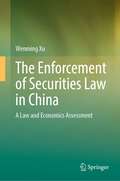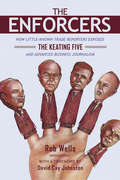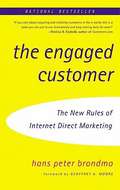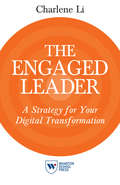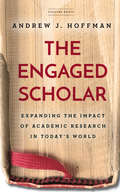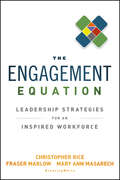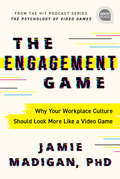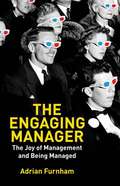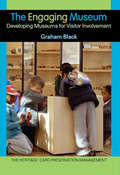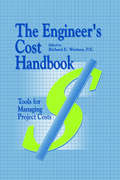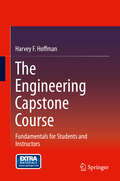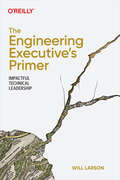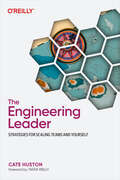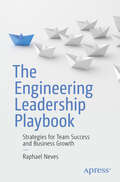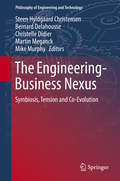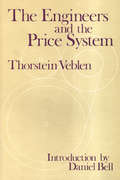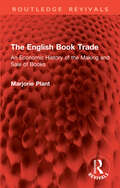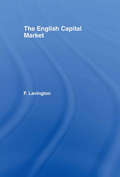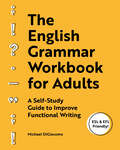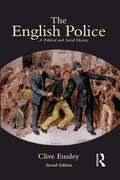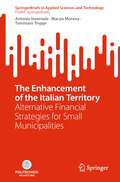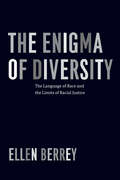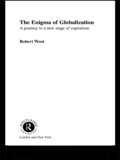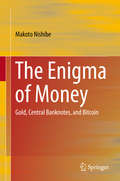- Table View
- List View
The Enforcement of Securities Law in China: A Law and Economics Assessment
by Wenming XuThis book takes a law and economic approach to examine the securities law enforcement in China and provides an in-depth empirical analysis on the enforcement inputs and outputs. In contrast to previous studies, it systematically collects a large sample of judicated securities fraud cases and public sanctions as disclosed by the listed companies. The enforcement regime is further divided into the private enforcement exemplified by the civil litigation imitated by harmed investors and public enforcement by sanctions proceedings initiated by public agencies. Academic researchers, policy makers and practitioners, who are interested in the securities market and regulation could find the information provided in this book interesting.
The Enforcers: How Little-Known Trade Reporters Exposed the Keating Five and Advanced Business Journalism (History of Communication #148)
by Rob WellsIn the 1980s, real estate developer and banker Charles H. Keating executed one of the largest savings and loans frauds in United States history. Keating had long used the courts to muzzle critical reporting of his business dealings, but aggressive reporting by a small trade paper called the National Thrift News helped bring down Keating and offered an inspiring example of business journalism that speaks truth to power. Rob Wells tells the story through the work of Stan Strachan, a veteran financial journalist who uncovered Keating's misdeeds and links to a group of US senators—the Keating Five—who bullied regulators on his behalf. Editorial decisions at the National Thrift News angered advertisers and readers, but the newsroom sold ownership on the idea of investigative reporting as a commercial opportunity. Examining the National Thrift News's approach, Wells calls for a new era of business reporting that can—and must—embrace its potential as a watchdog safeguarding the interests of the public.
The Engaged Customer
by Hans Peter BrondmoIn the age of the Internet, how do you keep your customers coming back--again and again--when your competitors are always just one click away? How do you turn casual, anonymous surfers into profitable, "engaged" customers?The answers to these questions can be found in The Eng@ged Customer, written by Hans Peter Brondmo, one of the Internet's best known and most successful direct marketing experts. In this new marketing classic Brondmo introduces readers to the new rules of Internet direct marketing and shows them how to use email to build service rather than marketing relationships.A visionary in both the technology and marketing arenas, Brondmo has shown more company executives than anyone how to build lasting, profitable, one-on-one relationships with customers on the Internet. His client list includes such household names as Palm, Hewlett-Packard, Victoria's Secret, Amtrak, Wells Fargo Bank, OfficeMax, Wegmans Food Markets, as well as such Internet leaders as CDNow, E-Trade Women.com, Petopia.com, Sparks.com, and eBags.com.The Eng@ged Customer makes Brondmo's expertise available to executives, managers, and marketers in both Old and New Economy businesses. The book combines a strategic perspective with tactical guidance, showing where and how to invest in order to build an Internet direct marketing program, and how to plan, develop, and implement your program for maximum success.While sending email messages to customers may sound like a simple process, retailers and marketers all over the world have discovered just how difficult it is to do it well. Let Brondmo show you how todesign email communications and marketing programs that have your customers complaining if they don't hear from you understand and manage customer information so that you can "get to know" each and every customer--even if you've got millions avoid spam and the potential nightmare of privacy violations anticipate the organizational impact of customer-focused Internet direct marketing define, measure, and track your success.Whether you are an executive or a manager, The Eng@ged Customer will show you: how to keep your customers coming back how to rise above the increasing Internet clutter how to become the trusted voice that your customers rely on.
The Engaged Leader: A Strategy for Your Digital Transformation
by Charlene LiNYT and WSJ bestselling author Charlene Li guides business leaders deeper than ever before into the uncomfortable and ever-changing terrain of the digital era Technology has revolutionized the very idea and nature of relationships between leaders and their followers. Yet, many leaders remain stuck at arms-length from those they lead and serve, relying on specialized teams to interact with customers, their direct reports to keep tabs on how employees are doing, and on the digital natives in their organization to stay abreast of new technologies.Now, in The Engaged Leader: A Strategy for Your Digital Transformation, Li helps leaders adapt to the demands, and opportunities of digital leadership. To be a true digital leader requires a metamorphosis: you must connect directly by listening, sharing, and engaging using digital technologies. This metamorphosis is not easy, comfortable, or painless-if your palms aren't sweaty or your stomach isn't churning, then you probably aren't really practicing digital leadership.The Engaged Leader addresses why leaders need to master a new way of developing relationships, which begins by stepping out of traditional hierarchies; how to listen at scale, share to shape, and engage to transform; the art of making this transformative mind shift; and the science of applying the right tools to meet your strategic goals.This transformation is not optional. Those who choose not to make this change will be abandoned for those who inspire people to follow them.The Engaged Leader provides leaders with the skills and confidence they need to transform their leadership, and in turn, their organizations. The Engaged Leader also provides guidance to institutions-businesses, communities, and schools-on how to develop and nurture digital leadership. It is a must read for anyone who values a deeper connection between leaders and those they serve.
The Engaged Scholar: Expanding the Impact of Academic Research in Today’s World
by Andrew J. HoffmanSociety and democracy are ever threatened by the fall of fact. Rigorous analysis of facts, the hard boundary between truth and opinion, and fidelity to reputable sources of factual information are all in alarming decline. A 2018 report published by the RAND Corporation labeled this problem "truth decay" and Andrew J. Hoffman lays the challenge of fixing it at the door of the academy. But, as he points out, academia is prevented from carrying this out due to its own existential crisis—a crisis of relevance. Scholarship rarely moves very far beyond the walls of the academy and is certainly not accessing the primarily civic spaces it needs to reach in order to mitigate truth corruption. In this brief but compelling book, Hoffman draws upon existing literature and personal experience to bring attention to the problem of academic insularity—where it comes from and where, if left to grow unchecked, it will go—and argues for the emergence of a more publicly and politically engaged scholar. This book is a call to make that path toward public engagement more acceptable and legitimate for those who do it; to enlarge the tent to be inclusive of multiple ways that one enacts the role of academic scholar in today's world.
The Engagement Equation: Leadership Strategies for an Inspired Workforce
by Christopher Rice Fraser Marlow Mary Ann MasarechCreate a culture of engagement and build high-performance culture The Engagement Equation explains the drivers of employee engagement, and how you can use improved engagement to execute strategy, reduce costs, and meet your organizational goals. This book describes a unique engagement model that focuses on individuals' contribution to a company's success and personal satisfaction in their roles. Aligning employees' values, goals, and aspirations with those of the organization is the best method for achieving the sustainable employee engagement. The Engagement Equation is designed to provide a framework that will help you move the needle on engagement. Explains how to plan and execute a sustainable organization-wide engagement initiative Shows how to avoid the engagement survey analysis-paralysis trap Shares ways to align employee contribution with strategy Encourages leaders to pay attention to and better understand your organizational culture, and much more Ultimately, it's the daily dynamics at play in your team, your division, and your organization that matter most.
The Engagement Game: Why Your Workplace Culture Should Look More Like a Video Game (Ignite Reads)
by Jamie MadiganMake work FUN with lessons in engagement that game play can teach us ALLIn videogames, like in any modern workplace, cooperation, continuous learning, hard work, engagement, and a balanced slate of skills are all keys to victory. A lot of thought and science goes into engineering the gamer's experience to provide feedback exactly when it is needed so they can get better and understand how the game works.What if your workplace was designed the same way?Combine the psychology of game design and industrial organizational psychology and you have the perfect formula to become a better leader, manager, coach, and coworker. Ready? Game on.
The Engaging Manager
by Adrian FurnhamIn this new collection of articles on managing and being managed, Adrian Furnham, author of Bad Apples , offers an engaging and witty look into the world of being an engaging manager. Based on strong research this book offers a substantial introduction to the joy of management.
The Engaging Museum: Developing Museums for Visitor Involvement (The\heritage: Care - Preservation - Management Ser.)
by Graham BlackThis very practical book guides museums on how to create the highest quality experience possible for their visitors. Creating an environment that supports visitor engagement with collections means examining every stage of the visit, from the initial impetus to go to a particular institution, to front-of-house management, interpretive approach and qualitative analysis afterwards. This holistic approach will be immensely helpful to museums in meeting the needs and expectations of visitors and building their audience. This book features: includes chapter introductions and discussion sections supporting case studies to show how ideas are put into practice a lavish selection of tables, figures and plates to support and illustrate the discussion boxes showing ideas, models and planning suggestions to guide development an up-to-date bibliography of landmark research. The Engaging Museum offers a set of principles that can be adapted to any museum in any location and will be a valuable resource for institutions of every shape and size, as well as a vital addition to the reading lists of museum studies students.
The Engine of Enterprise: Credit in America
by Rowena OlegarioTracing credit from colonial times to the present and highlighting its productive role in building national prosperity, Rowena Olegario probes questions that have divided Americans: Who should have access to credit? How should creditors assess creditworthiness? How can borrowers and lenders accommodate to the risks of a credit-dependent economy?
The Engineer's Cost Handbook: Tools for Managing Project Costs
by Richard E. WestneyOffers coverage of each important step in engineering cost control process, from project justification to life-cycle costs. The book describes cost control systems and shows how to apply the principles of value engineering. It explains estimating methodology and the estimation of engineering, engineering equipment, and construction and labour costs; delineates productivity and cash-flow analysis; and more.
The Engineering Capstone Course
by Harvey F. HoffmanThis essential book takes students and instructors through steps undertaken in a start-to-finish engineering project as conceived and presented in the engineering capstone course. The learning experience follows an industry model to prepare students to recognize a need for a product or service, create and work in a team; identify competition, patent overlap, and necessary resources, generate a project proposal that accounts for business issues, prepare a design, develop and fabricate the product or service, develop a test plan to evaluate the product or service, and prepare and deliver a final report and presentation. Throughout the book, students are asked to examine the business viability aspects of the project. The Engineering Capstone Course: Fundamentals for Students and Instructors emphasizes that a design must meet a set of realistic technical specifications and constraints including examination of attendant economics, environmental needs, sustainability, manufacturability, health and safety, governmental regulations, industry standards, and social and political constraints. The book is ideal for instructors teaching, or students working through, the capstone course.
The Engineering Executive's Primer: Impactful Technical Leadership
by Will LarsonAs an engineering manager, you almost always have someone in your company to turn to for advice: a peer on another team, your manager, or even the head of engineering. But who do you turn to if you're the head of engineering? Engineering executives have a challenging learning curve, and many folks excitedly start their first executive role only to leave frustrated within the first 18 months.In this book, author Will Larson shows you ways to obtain your first executive job and quickly ramp up to meet the challenges you may not have encountered in non-executive roles: measuring engineering for both engineers and the CEO, company-scoped headcount planning, communicating successfully across a growing organization, and figuring out what people actually mean when they keep asking for a "technology strategy."This book explains how to:Get an engineering executive job, negotiate the contract, and onboard at your new companyRun an engineering planning process and communicate effectively with the organizationDirect the core meetings necessary to operate an effective engineering organizationHire, onboard, and run performance managementManage yourself and remain effective through many challengesLeave the job when the time is rightWill Larson was the chief technology officer at Calm and the author of An Elegant Puzzle and Staff Engineer. He's also a prolific writer on his blog, Irrational Exuberance.
The Engineering Leader: Strategies for Scaling Teams and Yourself
by Cate HustonGreat engineers don't necessarily make great leaders—at least, not without a lot of work. Finding your path to becoming a strong leader is often fraught with challenges. It's not easy to figure out how to be strategic, successful, and considerate while also being firm. Whether you're on the management or individual contributor track, you need to develop strong leadership skills.This practical book shows you how to become a well-rounded and resilient engineering leader.Understand what it means to be the driving force behind your careerLearn how to self-manage and avoid the pitfalls that many newer managers faceEstablish evolving practices and structures to best scale your teamDefine the impact of your team and its core mission and values
The Engineering Leadership Playbook: Strategies for Team Success and Business Growth
by Raphael NevesIn today's business landscape, software engineering teams must deliver innovation faster than ever. However, outdated management approaches centered on tools and metrics rather than people strangle velocity and creativity. Legacy leaders cling to rigid structures mismatched with market dynamics, draining effort and morale from burnt-out teams. The Engineering Leadership Playbook provides a modern framework to unlock your team's potential through empathy, clarity, and empowerment. Unlike traditional leadership books fixated on delivery metrics, Raphael Neves offers a refreshing people-oriented leadership model tailored to nuances of engineering culture. With 15+ years leading high-growth tech teams, Raphael demystifies how to balance autonomy with alignment, reconstruct feedback models on psychological safety, and sustain excellence amidst uncertainty. You'll learn his proven conflict resolution blueprint for defusing clashes through mutual understanding while tangibly tracking progress. Additionally, his continuous feedback system grounded in evidence spotlights gaps early while accelerating strengths. This playbook moves systematically from foundational concepts like emotional intelligence and leading by example into team development frameworks around high-impact coaching, mentorship, and performance reviews. The method is brought full circle through innovation catalysts that maintain creative momentum at scale. Step-by-step, Raphael unpacks human-centered leadership aligned with accelerating market realities. Apply his engineering management playbook, and your teams will thrive fueled by vision, trust, and care. What You'll Learn Study different leadership styles and how to switch their approaches depending on circumstances Review critical communication skills, especially in technical fields Create IDPs for team members, especially senior engineers and leaders Who This Book Is For Current engineering leaders, aspiring engineering leaders, senior engineers, HR professionals and recruiters, and professionals in related fields
The Engineering-Business Nexus: Symbiosis, Tension and Co-Evolution (Philosophy of Engineering and Technology #32)
by Steen Hyldgaard Christensen Christelle Didier Martin Meganck Mike Murphy Bernard DelahousseFascinating and compelling in equal measure this volume presents a critical examination of the multilayered relationships between engineering and business. In so doing the study also stimulates ethical reflection on how these relationships either enhance or inhibit strategies to address vital issues of our time. In the context of geopolitical, economic, and environmental tendencies the authors explore the world that we should want to create and the role of the engineer and the business manager in this endeavor. Throughout this volume the authors identify periods of alignment and periods of tension between engineering and business. They look at focal points of the engineering-business nexus related to the development of capitalism. The book explores past and present movements to reshape, reform, or reject this nexus.The volume is informed by questions of importance for industry as well as for higher education. These are: What kinds of conflict arise for engineers in their attempts to straddle both professional and organizational commitments? How should professionals be managed to avoid a clash of managerial and professional cultures? How do engineers create value in firms and corporations? What kinds of tension exist between higher education and industry? What challenges does the neoliberal entrepreneurial university pose for management, faculty, students, society, and industry? Should engineering graduates be ready for work, and can they possibly be? What kinds of business issues are reflected in engineering education curricula, and for what purpose? Is there a limit to the degree of business hybridization in engineering degree programs, and if so, what would be the criterion for its definition? Is there a place in engineering education curricula for reflective critique of assumptions related to business and economic thinking? One ideal of management and control comes to the fore as the Anthropocene - the world transformed into an engineered artefact which includes human existence. The volume raises the question as to how engineering and business together should be considered, given the fact that the current engineering-business nexus remains embedded within an economic model of continual growth. By addressing macro-level issues such as energy policy, sustainable development, globalization, and social justice this study will both help create awareness and stimulate development of self-knowledge among practitioners, educators, and students thereby ultimately addressing the need for better informed citizens to safeguard planet Earth as a human life supporting system.
The Engineers and the Price System
by Thorstein VeblenIn his The Engineers and the Price System, originally published in 1921, Veblen observes that World War One demanded industrial innovations, and he was among the first to predict the need for changes in managerial struc-ture. Veblen saw that industrial output was more dependent upon techno-crats managers and capital innova-tors than financiers.In The Engineers and the Price System, Veblen applies economic theory to modern industrial society. He demon-strates that revolutionary change can be advanced by managers and engi-neers upon whose "brains and skills" the state of industrial arts depends.In his uniquely comprehensive in-troduction, Daniel Bell discusses the associations and attitudes which mark Veblen as the prophetic outsider he remained most of his life.
The English Book Trade: An Economic History of the Making and Sale of Books (Routledge Revivals)
by Marjorie PlantOriginally published in 1938, and as a third edition in 1974, this volume presents the results of original research into the economic aspects of the transition from the medieval manuscript to the modern printed book. It discusses the problems of supply of materials and labour created by the introduction of machinery and the growth of the literary market. The social evolution of the printing crafts is portrayed, focussing first upon the Stationers’ Company and later upon the trade union. The book traces the development of the author-printer-publisher relationship, and its bearing on the question of copyright and reviews, inter alia the organisation and price policy of bookselling from the days of legal maximum prices to the net book agreement. The 3rd edition contains sections on Public Lending Right, paperbacks, photo-copying in its relation to publishing and the rise of international publishing..
The English Capital Market (Reprints Of Economic Classics Ser.)
by Frederick LavingtonFirst Published in 1968. Routledge is an imprint of Taylor & Francis, an informa company.
The English Grammar Workbook for Adults: A Self-Study Guide to Improve Functional Writing
by Michael DiGiacomoThe engaging, self-guided way to sharpen your grammar and write better!Mastering English grammar can be a real challenge. But never fear! The English Grammar Workbook for Adults is here to help improve your writing fluency so you can feel confident while crafting emails, cover letters, birthday cards and more.No matter your current skill level, this English grammar workbook has everything you need to learn essential elements, including nouns, verbs, adjectives, adverbs, tenses, and beyond. Then, you'll apply what you've learned to everyday situations you could encounter at school, at work, social situations, creative writing, online, and more.Fun & functional—This clear, concise book is essential for ESL/EFL and other grammar students who want to work on writing English.Situational success—Get expert tips on how grammar applies to real-world scenarios.Easy to use—Find quick answers to your English grammar questions using text boxes and the expanded index in the back of the book.Learning how to communicate more clearly is a snap with The English Grammar Workbook for Adults.
The English Police: A Political and Social History
by Clive EmsleyA comprehensive history of policing from the eighteenth century onwards, which draws on largely unused police archives. Clive Emsley addresses all the major issues of debate; he explores the impact of legislation and policy at both national and local levels, and considers the claim that the English police were non-political and free from political control. In the final section, he looks at the changing experience of police life. Established as a standard introduction to the subject on its first appearance, the Second Edition has been substantially revised and is now published under the Longman imprint for the first time.
The Enhancement of the Italian Territory: Alternative Financial Strategies for Small Municipalities (SpringerBriefs in Applied Sciences and Technology)
by Antonio Invernale Marzia Morena Tommaso TruppiThis book presents some alternative models and financial instruments for the enhancement of public properties and urban regeneration operations. Set against the backdrop of the current scenario of competition between cities to attract investments (but also of cooperation in front of challenges posed by sustainable development issues), the book describes the role played by Public Administrations through the measurement and comparison of their efficiency in the bureaucratic procedures in the field of real estate and their knowledge and use of some alternative financial tools, particularly civic crowdfunding. Following a brief overview of public-private partnership, the book highlights the potentialities of civic crowdfunding for the enhancement of public real estate assets in the Italian territory, related to small municipalities, also including some case studies. These good practices prove civic crowdfunding a useful tool not only to finance and implement public interest initiatives, but also to transparently and directly involve citizens.
The Enigma of Diversity: The Language of Race and the Limits of Racial Justice
by Ellen BerreyDiversity these days is a hallowed American value, widely shared and honored. That's a remarkable change from the Civil Rights era--but does this public commitment to diversity constitute a civil rights victory? What does diversity mean in contemporary America, and what are the effects of efforts to support it? Ellen Berrey digs deep into those questions in The Enigma of Diversity. Drawing on six years of fieldwork and historical sources dating back to the 1950s and making extensive use of three case studies from widely varying arenas--housing redevelopment in Chicago's Rogers Park neighborhood, affirmative action in the University of Michigan's admissions program, and the workings of the human resources department at a Fortune 500 company--Berrey explores the complicated, contradictory, and even troubling meanings and uses of diversity as it is invoked by different groups for different, often symbolic ends. In each case, diversity affirms inclusiveness, especially in the most coveted jobs and colleges, yet it resists fundamental change in the practices and cultures that are the foundation of social inequality. Berrey shows how this has led racial progress itself to be reimagined, transformed from a legal fight for fundamental rights to a celebration of the competitive advantages afforded by cultural differences. Powerfully argued and surprising in its conclusions, The Enigma of Diversity reveals the true cost of the public embrace of diversity: the taming of demands for racial justice.
The Enigma of Globalization: A Journey to a New Stage of Capitalism (Routledge Frontiers Of Political Economy Ser.)
by Robert WentGlobalization is theorized in this book as an emerging new stage of capitalism. Robert Went takes us on a journey from the historical roots of globalization through to its relevance in the modern day.The Enigma of Globalization is a timely addition to an important debate and covers such themes as:* International trade* Free trade and international
The Enigma of Money
by Makoto NishibeThis book provides a new way of understanding modern money and markets by stressing their self-fulfilling/self-destructive properties as institutions from evolutionary perspectives. In contrast to an unrealistic view of the neoclassical general equilibrium theory that models the price mechanism of a "concentrated market" without using money, presented here is an alternative theory of markets on how a realistic "dispersive market" using a stock of money and inventory as buffers can work as a multilayered price-quantitative adjustment system. The central features of modern sovereign moneys seen in inconvertible IOUs of central banknotes can be depicted as "The Emperor's New Clothes" that correspond to the U. S. dollar and the Euro void of their own value. The image captures such characteristics of national currencies as "self-fulfilling ideas" by the inertia of conventions in the past and expectations of an uncertain future. Both ideas normally make money more acceptable and circulative so that its value can become more stable unless expectations for the future turn very pessimistic. The same logic also applies to such other currencies as Bitcoin and community currencies. Their recent diffusion has shown that Hayek's idea of denationalization of money and competition between multiple currencies in terms of its qualities, not its quantities sought as in ongoing quantitative easing, become more relevant under current situations. The qualities of money refer not only to stable monetary values and low transaction costs, but also to high ability in creating, sharing, and communicating social and cultural value. The potential of the logic of self-fulfillment of ideas can thus open up a new economic society when we realize that such various non-national currencies all depend on the same logic of money.
